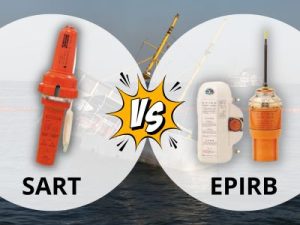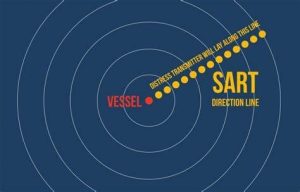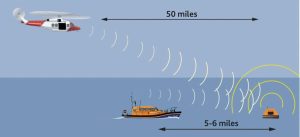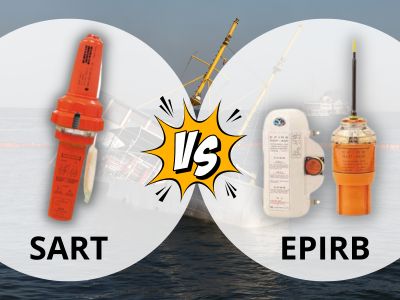In the world of maritime safety, especially during emergency situations like abandoning ship, every second and every piece of equipment matters. Among the most vital tools for survival at sea are the EPIRB (Emergency Position-Indicating Radio Beacon) and the SART (Search and Rescue Transponder). While both are part of the GMDSS (Global Maritime Distress and Safety System), their functions, placement, and importance in lifeboat operations differ. This educational article is tailored to ship cadets and officers to clarify the roles of EPIRB and SART, focusing especially on SART’s life-saving role in post-abandon ship scenarios.

Overview of GMDSS Equipment in Emergencies
The GMDSS was developed by the International Maritime Organization (IMO) to enhance maritime safety and ensure prompt and effective SAR (Search and Rescue) operations. The system includes a variety of communication and alerting tools, of which EPIRBs and SARTs are key components.
When a vessel is abandoned, survival equipment must not only ensure the safety and sustenance of survivors but also make them locatable. EPIRBs and SARTs serve this precise purpose through different technological means.
What is an EPIRB?
An EPIRB, or Emergency Position-Indicating Radio Beacon, is a satellite-based distress beacon. When activated, it sends out a coded distress signal on the 406 MHz frequency to the COSPAS-SARSAT satellite system. This system alerts rescue coordination centers (RCCs) worldwide, providing the vessel’s or survival craft’s last known position.
Key Features of EPIRB:
- Operates on 406 MHz with a 121.5 MHz homing signal.
- Transmits vessel identification and location data.
- Activation can be manual or automatic (via hydrostatic release).
- Battery life typically exceeds 48 hours.
- Float-free versions are installed on vessels and automatically deploy when submerged.
Important Note: EPIRBs are not typically carried inside lifeboats. They are installed on the ship, usually on the open deck or near the bridge, and are designed to float free and activate automatically if the ship sinks. In some cases, vessels may carry an additional EPIRB in a grab bag to be manually taken into the lifeboat, but this is not mandatory under SOLAS.

What is a SART?
A SART, or Search and Rescue Transponder, is a radar transponder device that helps rescuers locate survivors by responding to radar signals. When an X-band radar (9 GHz) from a ship or aircraft sweeps across the activated SART, the device sends back a series of distinctive echoes. These appear as a line of 12 dots or arcs on the radar screen, pinpointing the location of the survival craft.
Key Features of SART:
- Operates on X-band radar frequency (9.2 to 9.5 GHz).
- Battery-operated, typically lasts for 96 hours on standby, and 8 hours in response mode.
- Portable, manually activated, and waterproof.
- Effective range: up to 10 nautical miles (ship radar) and 30 nautical miles (airborne radar).
- Required by SOLAS to be stored in or with survival craft.


Regulatory Requirements (SOLAS Chapter III):
- Ships between 300 and 500 GT must carry at least one SART.
- Ships over 500 GT must carry at least two SARTs.
- SARTs must be stowed in locations where they can be easily transferred to survival craft during abandonment.
Functional Differences Between EPIRB and SART
| Feature | EPIRB | SART |
|---|---|---|
| Technology | Satellite beacon | Radar transponder |
| Frequency | 406 MHz + 121.5 MHz | X-band radar (9 GHz) |
| Signal Type | Satellite distress alert | Radar echo signal |
| Installed | On ship (float-free or manual) | In lifeboat/liferaft |
| Activation | Manual or automatic | Manual |
| Purpose | Global distress alert to RCC | Localized tracking by SAR units |
| Range | Worldwide (via satellite) | Line-of-sight (radar dependent) |
In essence, EPIRB is for long-range alerting, and SART is for short-range location by nearby ships or aircraft.
How SART Saves Lives After Abandoning Ship
SARTs are specifically designed to increase the chances of locating and rescuing survivors after they have abandoned ship and are adrift in lifeboats or liferafts. Here is how SART contributes to saving lives:
a. Becomes Visible on Radar
When a nearby ship or aircraft uses radar, the SART responds by creating a line of dots or arcs on the radar screen. These are easily distinguishable from normal radar echoes and direct the rescuer precisely to the lifeboat.
Benefit: Works even in total darkness, heavy fog, or rain—situations where visual detection is almost impossible.
b. Provides Real-Time Directional Location
Unlike EPIRBs which provide a position fix via satellite and may have delays or inaccuracies, a SART responds instantly to radar pulses, guiding rescuers in real-time. As the rescuing ship approaches, the radar display becomes clearer and more focused.
Benefit: Rescuers can follow a clear radar path to the survival craft, reducing search time.
c. Easy to Use
SARTs are designed to be user-friendly:
- Survivors only need to switch it on and elevate it using a telescopic pole or handheld.
- No external systems or GPS are needed.
- The device is waterproof and rugged.
Benefit: Ideal for high-stress situations with limited training or technical experience.
d. Effective in All Weather and Sea Conditions
Because SARTs depend on radar, they are not affected by cloud cover, GPS jamming, or satellite blackout. They work in high seas, strong winds, and other challenging conditions.
Benefit: Survivors remain visible to radar-equipped rescue units regardless of weather.
e. Battery Reliability
Most SARTs provide more than 96 hours of standby time and 8 hours of active signaling. This is sufficient to survive multiple SAR sweeps over a day or more.
Benefit: Increases the survival window for drifting lifeboats.
Real-World Application Scenario
Imagine a cargo ship experiences flooding due to hull breach and the crew evacuates into lifeboats. It’s midnight, visibility is zero due to storm conditions, and wind speeds are high. The EPIRB has been activated and has alerted RCC. Meanwhile, a rescue helicopter is dispatched and starts scanning the area using radar. The SART, mounted on a pole in the lifeboat, starts replying to radar signals. The helicopter pilot sees the radar echo trail from the SART and follows it. Within minutes, the lifeboat is located and survivors are rescued.
Conclusion: Without the SART, locating a single lifeboat in the open ocean at night would have been nearly impossible.
Best Practices for Officers and Cadets
To ensure maximum survival chances, all deck officers, engineers, and cadets should be familiar with these best practices:
- Pre-departure Checks: Verify EPIRB registration and SART battery status.
- Training Drills: Include SART activation and mounting during abandon ship drills.
- Proper Stowage: Know where SARTs are stored and how to transfer them quickly to lifeboats.
- Manual Handling: Be prepared to manually activate and elevate the SART.
- Grab Bag Strategy: If your vessel uses a grab bag system, ensure it contains an extra EPIRB or handheld GPS if possible.
Frequently Asked Questions
Q: Should the SART be switched on before or after entering the lifeboat? A: Switch it on after safely boarding and when you are ready to deploy it on a pole or handheld mount. Keep it dry and upright for best signal.
Q: Can I use a SART on land or from a sinking ship? A: Technically yes, but it is optimized for radar visibility at sea level. Use it only when in lifeboats or when final abandonment is underway.
Q: How many SARTs should be in a vessel with multiple lifeboats? A: SOLAS mandates at least 1 or 2 SARTs depending on vessel size, but ideally each survival craft should have one, especially if lifeboats may drift apart.
Conclusion
EPIRBs and SARTs are indispensable components of modern maritime safety. While the EPIRB ensures that your distress call is heard globally, the SART ensures that rescuers can find you in the vast, featureless ocean. Every minute counts in a rescue scenario, and proper knowledge and deployment of these devices can make the difference between life and death.
For ship cadets and officers, understanding the distinct roles and correct handling of EPIRB and SART devices is not just exam material—it’s a core survival skill.
Stay safe, stay trained, and always be ready.

